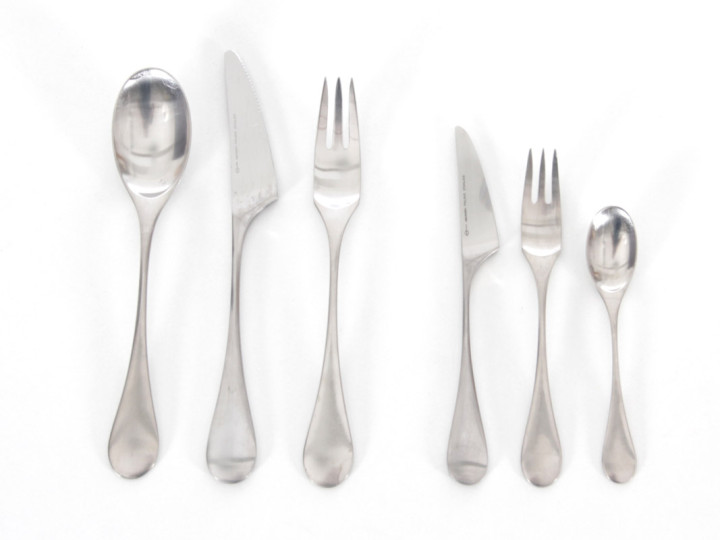Scandinavian mat steel cutlery set. Model Mango by Nanny Still. 70 pcs
-
Nanny Still
-
Frigast
- DV230503
Sold
12 large forks 20.5 cm; 12 Large Spoons 20.5cm; 12 Large knives 22 cm; 12 Small forks 16.5 cm: 12 Small knives 18.5 cm: 10 Small spoons 13.5 cm
Mango cutlery set was designed by Nanny Still in 1973. The inspiration for Nanny Still’s Mango cutlery set was her first sight of a mango fruit in India in the 1970’s. It resulted in an innovative substitute for traditional silverware that reflected the open-minded optimism of the era. The soft, round design in matt brushed stainless steel echoes the smooth, simple sculpture of the fruit, and has been interpreted across an entire range of cutlery. Mango fits into any table setting and can be complemented by Iittala's Collective Tools serving range.
| Year | 1960's |
| Condition | Excellent. Etat d'usage. |
| Material | Metal argenté |
| Style | Classique Vintage |
| Origin | Danemark. |
| Fournisseur | Hackman |
Nanny Still
Also known by her married name Nanny Still-McKinney, this woman is one of Finland's best-known ceramic and glass designers.
As a child, Still loved to draw and was determined at a young age to pursue an artistic career. She studied drawing and then industrial design at the Central School of Industrial Design in Helsinki. Even though she specialized in metal work as a student, she took a study trip to the glass factory in Riihimäki, north of Helsinki. This experience was such that she decided to join a glassware competition organized by the Riihiamäki glass factory. His plate of Herring then won the prize.
After graduating, Nanny Still was hired as a designer by Riihimäen Lasi Oy in 1949. For 25 years, she created everything from mouth-blown artwork to industrial glassware production. When it came to creating practical glassware, Still made sure his design was well thought out in terms of utility.
While working at the Riihimäki glass factory, she felt the urge to create new colors for the production of glassware and therefore undertook a long process of research in this field, collaborating with the chemical laboratories of the glass factory. The remarkable spectrum of smoky colors that she uses for her collection of so-called Koristepullo bottles, produced from 1959 to 1968, testifies to her talent as a glass technician and colorist. One of the shades she invented – a brilliant turquoise – was inspired by a shard of glass that came from the sea during a trip to Capri in Italy. Subsequently it was used for his Harlekiini pattern, which involved jugs, carafes, stemware and covered bowls. This elegant collection of glassware was notable for its refined forms which had strong graphic qualities, a peculiarity of Finnish design.
Throughout her career, Still has imbued her functional glassware with sculptural brilliance. From his young Pompadour vases (1945), with their undulating silhouettes, to his later creations with the Stella Polaris series (1967), Grapponia (1968), and Fenomena (1968-72), which have a highly textured surface, reflecting the growing informality of the time. Throughout her career, Nanny Still has been able to channel the latest design trends and also contribute to developing them. She continued to design for the Riihimäki Glass Factory until 1976, when they closed mouth-blown glass production to focus on mass production for utility bottles and jars.
In 1958, Nanny Still married an American, George McKinney, she moved with him to Belgium the following year, where she remained until the end of her life. She continues her design for Riihimäen Lasi Oy, she has also created glassmakers for Val Saint-Lambert and for Cérabel, both located in Belgium, but also for the German producers Heinrich and Rosenthal. She has also created lights for the Dutch company Raak, and plastic household items for Sarvis and jewelry for Kultakeskus, both located in Finland.
In 1958, Nanny Still, after marrying an American named George McKinney, moved with him to Belgium the following year, where she resided until the end of her life. During this period, she continued her design work for Riihimäen Lasi Oy. She also collaborated with Belgian companies such as Val Saint-Lambert and Cérabel, as well as with German manufacturers Heinrich and Rosenthal. In addition, she designs lighting for Dutch company Raak, as well as plastic household items for Sarvis and jewelry for Kultakeskus, both based in Finland.














